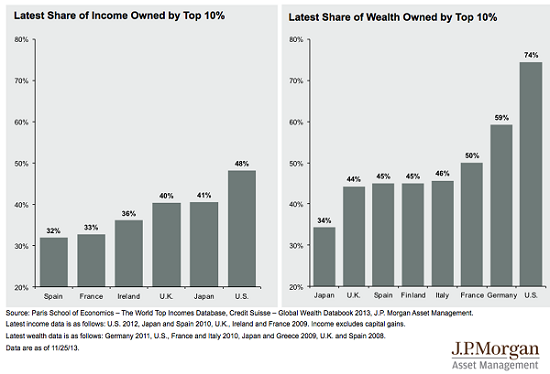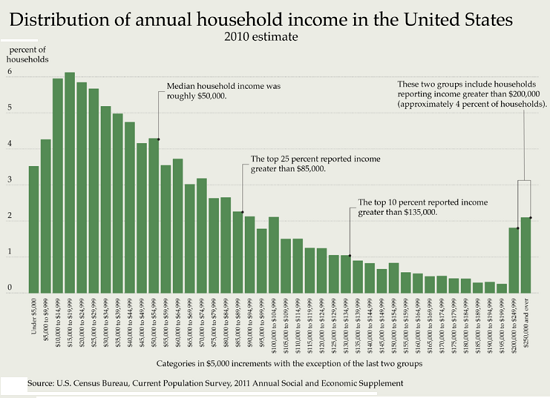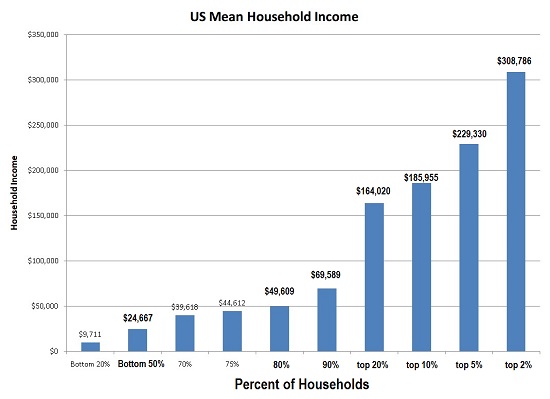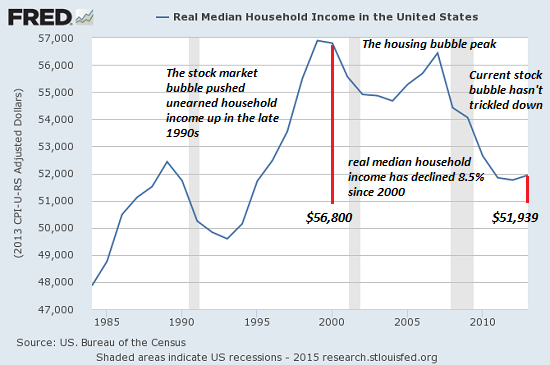Submitted by Charles Hugh-Smith of OfTwoMinds blog,
This chart of median household income illustrates why so many of us feel poorer– we are poorer in terms of the purchasing power of our income.
A rising tide raises all boats, from rowboats to yachts–this is the narrative of “prosperity.”
A rising tide is also the political cover for rising inequality: if the guy in the rowboat makes $100 more a month, he feels like he’s participating in the prosperity.
Meanwhile, the guy in the speedboat is making $1,000 more a month and the guy in the yacht is making $1 million more a month.
But this doesn’t bother the guy in the rowboat, for two reasons:
1. He thinks of himself as a guy who is currently in a rowboat on his way to buying a speedboat
2. Studies have found that our sense of wealth and “falling behind” is not defined by our actual increases in income or wealth, but by how we’re doing relative to our peer group. If everyone else in rowboats is making $200 more a month in the rising tide of prosperity, the guy making only $100 more feels like he’s falling behind–even if his absolute income and wealth is rising.
Conversely, if his peers are all suffering declines in income while his income is holding steady, he feels like he’s doing pretty well for himself, even though his income is stagnant.
The fact that the wealthy are gaining far more in “prosperity” in both absolute and relative terms doesn’t bother him as long as he’s doing as well or better as his peers and feels he has a chance to eventually move up from a rowboat to a speedboat.
But when the tide of “prosperity” (i.e. the fake prosperity of financialization and phony statistics) recedes, the ugly realities of massive wealth/income inequality are exposed for all to see. The guy in the rowboat starts wondering if he can ever move up to a speedboat, and then he starts noticing the guy with the yacht just moved up to a much grander yacht while the paint is flaking off his rowboat.
Let’s look at some charts for context.
Wealth/income inequality is significantly higher in the U.S. than in other developed nations.

This chart shows the number of people earning each bracket of income. Half of all households in the U.S. earn less than $53,000 annually, and 75% earn less than $85,000. (These numbers are from 2010; 2012/2013 numbers are slightly higher.)
You can identify your own relative status with this interactive link: What Percent Are You?

This chart of mean (average) household income shows the income of each segment to scale.

This chart of median household income illustrates why so many of us feel poorer– we are poorer in terms of the purchasing power of our income.

The acceptance of the multitude in rowboats for the few buying new yachts wears thin when the many sense their declining mobility and purchasing power. The illusion that the tide of “prosperity” is lifting all boats is dissipating into a mist that no longer offers cover to obscenely wealthy politicos disclaiming the ugly reality of rising wealth/income inequality.
The question for the chattering classes is this: will the bread and circuses of sports, random shootings, Trump and the rest of the churn in the media arena be enough to distract those stuck in leaky rowboats from the political fund-raising parties on the grandiose yachts?



I don’t even have a rowboat.
Michael Kazin, co-editor of the left-wing magazine Dissent, posed a simple question in a recent article: If wealth and income inequality levels are as bad as they are portrayed in popular media, “why aren’t people taking to the streets?”
The statistics that describe the magnitude of economic inequality are stark. Before taking into account the effects of redistributive government programs, the richest 1% of Americans make 20% of the income. Wealth inequality is even more extreme, with a recent study estimating that in America, the wealthiest 160,000 families have as much as the poorest 145 million families.
Such figures are rallying points for a specific strain of economic populism in America, manifested most saliently in the Occupy Wall Street movement. Occupy brought to the fore the idea that the nation is divided between a small group of haves and an increasingly large group of have-nots.
But if this is really the case, why aren’t Americans taking to the streets? They are not rioting, or even organizing to demand that the government solve the problems of inequality. And, in fact, poll numbers suggest Americans believe the government spends too much on the poor or is otherwise too involved in the economy.
Why do the statistics that supposedly describe the economic reality and Americans perceptions of that reality differ so much? For one, government programs do help—to a degree—cushion economic blows and redistribute wealth. But more importantly, the statistics that are trumpeted in much of the media do a poor job of describing the fluidity of the American economy.
A study published in January by sociologists Thomas Hirschl of Cornell University and Mark Rank of Washington University paints a much more nuanced picture. They use data from the government-sponsored Panel Study on Income Dynamics (PSID), which interviewed thousands of families from 1968 through 2011 to understand how these families’ economic fortunes evolved over time. The data paints a picture of a fluid economic order.
PSID data show that by age 60:
– 70% of the population will have experienced at least one year within the top 20th percentile of income;
– 53% of the population will have experienced at least one year within the top 10th percentile of income; and
– 11.1% of the population will have found themselves in the much-maligned 1% of earners for at least one year of their lives.
At the same time, it’s much more rare for a person to reach the top 1% and stay there. According to PSID data, only 0.6% of the population will experience 10 consecutive years in the top 1% of earners.
The fluidity cuts both ways. Rank and Hirschl pointed out in their 2014 book Chasing the American Dream that some 45% of Americans will take advantage of a need-based welfare program, like Medicaid or food stamps, by age 60. And 54% of Americans will experience at least one year of poverty by the same age.
Just because there is a good deal of changeability in America’s class structure, that doesn’t mean that everyone has the same chances at achieving high levels of income. Compared with many of its wealthy peers, there is much less inter-generational economic mobility in the U.S. If you are born poor in America, you have a much greater chance of staying poor than if you were born into the same class in places like Canada or Denmark.
But in the American economy, a given individual will experience a wide array of economic circumstances throughout their lives. This is why, for instance, aspirational advertising campaigns are so effective: because millions of Americans really do climb the economic ladder over the course of their lives.
This insight is also useful in politics. Liberals often marvel at the phenomenon of citizens in conservative states who vote “against their own economic interests.” But many of these people may very well have been in the top tiers of earners at some point in their lives, and they may expect to get back to that lofty perch again.
Income and wealth inequality will continue to shape the world for years to come, and they are not issues the business community can ignore. But when you take a closer look at the data, you see that class in America is much more complicated than a simple story of the 1% against the 99%. Why aren’t Americans taking to the streets, ready to fight the next class war? It’s because many of us wouldn’t know which side we’re on.
My problem with this type of article is the idea that is becoming increasingly more ingrained in popular belief that the richer the person is the more the person is some type of crook that has to have acquired that wealth by screwing over everyone else. The idea is that across the wealth spectrum the percentage of crooks that manipulates and scams the system is higher the closer you get to the top. This is just not true. The reality is that there are crooks and scam artist at all levels of society and the level of one’s wealth is in no way an accurate gauge of one’s integrity.
For every Burnie Madoff there are tens of thousands of dishonest auto mechanics that will charge you for something that didn’t need to be done or may not have been done at all. For every Jamie Diamond there are Untold numbers of Mortgage Brokers and Real Estate agents that talked millions of people into Real Estate transactions that destroyed them financially. And make no mistake about it these Mortgage Brokers and Real Estate agents in the majority of cases knew that they were setting up these people to fail. At the ghetto level there are all kinds of scammers that will fuck you over for pocket change.
When the SHTF the “have nots” are going to want to go after someone to blame, And with the limited simplistic thinking ability of the average person (50% of the population = less then 100iq) they’re simply going to go after anyone that has more than they do.
In my case I have what I have due to a life time of hard work and sacrifice and by living within my means, and not by ever having screwed anyone. But that’s not going to matter at all to the have nots when they come looking for someone to blame. If you or I have more than they, then you/I must be one of the ones that stole from them.
And So It Goes.
Greetings,
The entertainment industry is, in my opinion, a microcosm of the society at large. For example, the earnings in the music business are very much concentrated in our 1%. The vast majority of musicians, producers, record labels, writers, etc never make so much as a penny. Perhaps 1 in 10 can do it profitably. But, and this is important, everyone within that community wants to live that life. Everyone wants to be that guy that supports himself by singing, playing a guitar or recording bands. Money for nothin’ and your chicks for free.
Those that have figured out a way to do it inspire everyone else to try. After all, it isn’t the government that picks the winners and losers like the greater society but mostly blind luck. We all wanna get lucky.
I think the Charles Smith is correct in that the people do not rise up because they may get lucky as well.
I’m expecting much worse than just the lower half of the public to run out of their one weeks worth of Federal government approved stored food. Man made and Natural Disasters, war, famine, and disease will cause food to become so scarce for over 300 million Americans that FEMA camps won’t be safe shelter; they will prey on each other and try the Preppers who will need about 500 rounds each for defense. Imported food, fuel, drinkable water, semi-trucks for transport, grocery stores, electricity, and highway safety will not exist. What is happening in Europe and the paucity of and civility of the Muslim refugees is nothing compared to what will occur in our country especially among the Urban Jungle FSA secular humanist. There will be skirmishes over the well marbled Long Pork lying on the ground until it’s all gone. The Elite and their DUMBs won’t be good enough. Jesus said no flesh would survive unless He shortens those days.